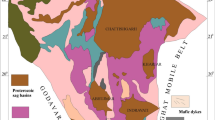Abstract
The geochemical evolution of the fluids migra- ting at the Variscan thrust front in eastern Belgium has been investigated by a petrographic, mineralogical and geoche-mical study of ankerite, quartz and ferroan calcite veins hosted by lower Devonian rocks. Three vein generations have been recognized. The first generation consists of quartz, chlorite and ankerite filling pre- to early Variscan extensional fractures. The second generation is present as shear veins of Variscan age, and contains quartz, chlorite and ferroan calcite. The third generation consists of ankerite filling post-Variscan fractures. The oxygen and carbon isotopic composition of the two ankerite phases and of the ferroan calcites are respectively between –16.4 and –11.4‰ PDB between –17.8 and –1.7‰ PDB. This range is greater than that of calcite nodules in the lower Devonian siliciclastic sediments (δ18O= –15.6 to –11.1‰ PDB and δ13C= –13.4 to –10.2‰ PDB). This suggests precipitation of the carbonate veins from a fluid which was at most only partly isotopically buffered by the calcite nodules in the host rock. The calculated oxygen isotopic composition of the ambient fluid from which the calcite veins formed is between +7.8 and +10.0‰ SMOW. Two main fluid types have been recognized in fluid inclusions in the quartz and carbonates. The first fluid type is present as secondary fluid inclusions in the first and second vein generations. The fluid has a salinity of 0.5–7.2 eq. wt.% NaCl and a high, but variable, homogenization temperature (Th=124–188°C). Two origins can be proposed for this fluid. It could have been expelled from the lower Devonian or could have been derived from the metamorphic zone to the south of the area studied. Taking into account the microthermometric and stable-isotope data, and the regional geological setting, the fluid most likely originated from metamorphic rocks and interacted with the lower Devonian along its migration path. This is in agreement with numerical simulations of the palaeofluid and especially the palaeotempera-ture field, which is based on chlorite geothermometry and vitrinite reflectance data. The second fluid type occurs as secondary inclusions in the shear veins and as fluid inclusions of unknown origin in post-Variscan ankerite veins. Therefore, it has a post-Variscan age. The inclusions are characterized by a high salinity (18.6–22.9 eq. wt.% CaCl2). The composition of the fluid is similar to that which caused the development of Mississippi Valley-type Pb–Zn deposits in Belgium.
Similar content being viewed by others
Author information
Authors and Affiliations
Additional information
Received: 28 May 1997 / Accepted: 8 July 1998
Rights and permissions
About this article
Cite this article
Muchez, P., Zhang, Y., Dejonghe, L. et al. Evolution of palaeofluids at the Variscan thrust front in eastern Belgium. Geol Rundsch 87, 373–380 (1998). https://doi.org/10.1007/s005310050216
Issue Date:
DOI: https://doi.org/10.1007/s005310050216




